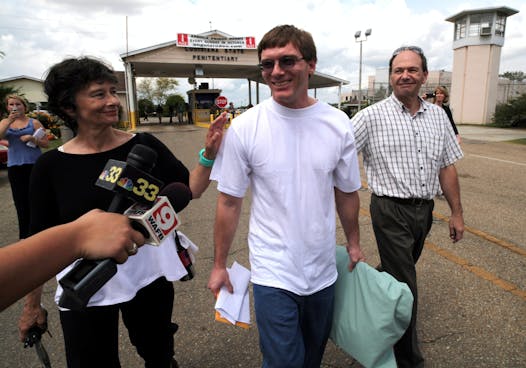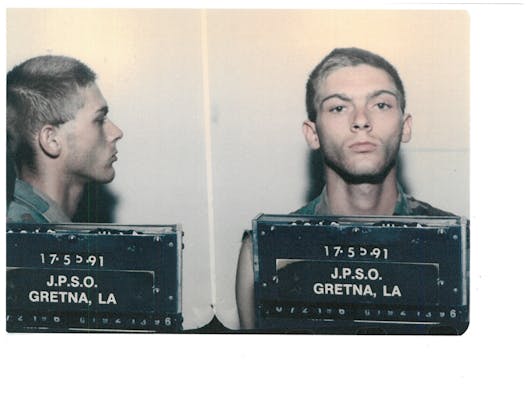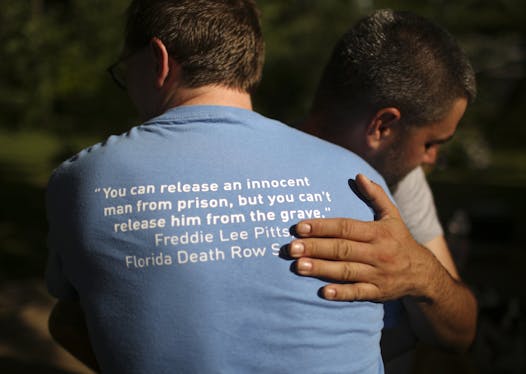The executioner haunts Damon Thibodeaux.
Nightmares yank him back to the 8-by-10-foot cell that confines him to solitary 23 hours a day. Loneliness overwhelms him; despair crushes his spirit. He wants to scream: "I'm innocent." He knows it won't matter.
The guards come for him, strap him to the table and push a needle into his arm. A lethal serum flows into his veins. Soon it will be over.
He jolts awake, his heart pounding.
The prison chains are gone and he's lying in his one-room Minneapolis apartment, 1,200 miles from the Louisiana penitentiary where he waited to die for a murder he didn't commit.
Thibodeaux is free from death row. Now, after more than 15 years in prison, will he be able to find his place in a world that raced ahead without him? Can he break free of a past that for so long kept him in chains?
A girl goes missing
It was a hot Louisiana summer day on Thursday, July 18, 1996, and Thibodeaux was a 22-year-old deckhand on a Mississippi River barge. After work that day, he went to visit relatives — Dawn and C.J. Champagne. He had come to New Orleans three weeks earlier for a wedding, then stayed to be closer to his mother and his sister and to work on the river.
After drinking late into the night, Thibodeaux slept at the Champagnes' apartment. He was still there at 5:15 Friday afternoon when their 14-year-old daughter, Crystal Champagne, left to walk to a nearby Winn-Dixie supermarket.
She never returned.
Thibodeaux and the family scoured the neighborhood through that night and into the next day while the Jefferson Parish Sheriff's Office launched an investigation. Thibodeaux had returned to his mother's home to sleep when sheriff's deputies knocked on his door, searching for answers.
Thibodeaux wanted to find Crystal, his step-cousin, as much as anyone and agreed to go with them and answer questions.
Minutes later, the missing-person case became a murder investigation. A former neighbor of the Champagnes found the girl's body in a wooded area along the Mississippi River beneath the Huey P. Long Bridge, about 5 miles from the family's home in Westwego.
Fourteen-year-old Crystal Champagne's body was found along the Mississippi River beneath the Huey P. Long in Jefferson Parish, La., in July 1996.
Thibodeaux, whose only previous run-ins with the law were for two misdemeanor marijuana possession convictions, waived his right to an attorney and spent the next 2½ hours sitting alone in a room, anxious and exhausted. He hadn't eaten or slept much over the past 30 hours.
Court records and interviews reveal what happened next. The investigators hammered him about the girl's death. When he said he knew nothing about it, they accused him of lying. They told him that Crystal's family didn't corroborate his whereabouts or his story. They said the evidence showed he raped and murdered the girl. They suggested he might not remember, that sometimes people black out and kill their victims without even knowing it.
And the polygraph test that he took at 1 a.m.? They told him he failed it.
Thibodeaux fell to the floor, spent and afraid.
Investigators told him he would be labeled a child rapist and murderer in prison. They graphically described a three-drug execution cocktail that would drip into his veins and burn. Confess, they said, and he might get leniency.
Key dates in the Thibodeaux case
July 19, 1996Crystal Champagne is killed and her body is found under the Huey P. Long Bridge in Bridge City, La.
July 21, 1996 Damon Thibodeaux confesses at 4:40 a.m. to beating, choking, raping and strangling Crystal.
Oct. 3, 1997 Jury finds Thibodeaux guilty of first-degree murder.
Oct. 24, 1997 Thibodeaux is sentenced to death and sent to Louisiana State Penitentiary at Angola.
April 3, 2001 Minneapolis law firm of Fredrikson & Byron begins work on Thibodeaux’s case.
Dec. 2002 The Innocence Project of New York and Barry Scheck join the team.
May 31, 2007 Jefferson Parish District Attorney Paul Connick Jr. agrees to work with Thibodeaux’s legal team on a joint re-investigation.
Sept. 27, 2012 The district attorney agrees to file a motion overturning Thibodeaux’s conviction; the judge orders his release.
Sept. 28, 2012 Thibodeaux walks off death row.
Oct. 4, 2012 Thibodeaux arrives in Minneapolis.
Jan. 22, 2013 Thibodeaux receives his GED.
Feb. 25, 2014 Thibodeaux testifies before subcommittee of the U.S. Senate Judiciary Committee.
"They were never going to let me out until I gave them what they wanted," Thibodeaux said. "It's not about what you believe you did, it's about trying to get away."
No evidence, but a confession
At 4:40 a.m. Sunday, after nine hours of interrogation, Thibodeaux confessed, stitching together a story with details he gleaned from his interrogators.
Damon Thibodeaux is free from death row after more than 15 years in prison.
"I didn't — I didn't know that I had done it," he told investigators. "I would say that I got scared, so I killed her."
He passed out on the way to jail. "When I woke up, I knew the damage was done," he said. "You can scream as loud as you want, but no one is hearing."
Within 36 hours, new facts about the crime emerged — details that didn't match Thibodeaux's confession.
He confessed to rape; the autopsy showed no sexual contact. He said he used his hands to choke her; the autopsy showed she wasn't choked by hand. He said he hit her with his hand; the autopsy showed she was bludgeoned with a heavy object, her skull fractured. He said he left her lying face down; she was left face up.
Six weeks later, forensic results on 86 pieces of physical evidence confirmed there was no rape, no sexual contact and nothing that connected Thibodeaux to the girl, her body, clothing or crime scene.
But prosecutors had his confession to rape and murder.
"A confession is the most powerful, incriminating evidence law enforcement can obtain," said Steve Kaplan, a Minneapolis lawyer who later became one of Thibodeaux's lead post-conviction attorneys. "Once the jury hears that confession, you're 95 percent on your way to conviction. The average juror can't believe anyone would give a false confession, especially to a heinous crime."
But since 1989, the Innocence Project has found that 31 percent of 330 DNA exonerees were convicted based on false confessions, admissions or guilty pleas.
Many who falsely confess said they did so thinking it would put a stop to a grueling interrogation. They believed the truth would come out later.
Thibodeaux's trial began on a Monday — Sept. 29, 1997, a little more than a year after his arrest. That Friday, the jury deliberated an hour and returned with its verdict: guilty of first degree murder.
The words numbed Thibodeaux.
The next day, the jury found him guilty of aggravated rape while murdering the 14-year-old. He was sentenced to die.
Shackled and riding in the back of a squad car to Louisiana State Penitentiary at Angola., he kept his eyes on the night sky. He never expected to see stars again.
Making peace with death
Amid the monotony and isolation of death row, Thibodeaux spiraled into a void he couldn't escape. Like a zoo animal, he paced. Five steps each way around the cell — one, two, three, four, five, turn. When the sweltering summer heat pushed the temperature past 100, he sat motionless for hours.
"It's about as lonely as it gets. You miss the sense of touch," he said. "The walls start to close in on you. You watch friends walk away to be executed. One day they would come for me."
Not wanting to prolong the misery, Thibodeaux decided against launching a string of appeals that likely would keep him languishing on death row for decades.
"The grave is the only way out," he said.
Then Denise LeBoeuf, an attorney working for the Capital Post-Conviction Project of Louisiana, walked into his life.
She sat in the prison visiting room, looking at a man who seemed more like a boy behind large wire-rimmed glasses. He was thin, depressed, fragile-looking, she said. She was convinced Thibodeaux was innocent and wanted a chance to prove it.
He decided to let her try.
Louisiana State Penitentiary's death row is housed in a new, modern facility.
Even after Thibodeaux's routine appeals were denied, LeBoeuf refused to give up. Others joined forces with her and colleague Caroline Tillman. The Minneapolis law firm Fredrikson & Byron, having recently lost a death-row case in Louisiana, dedicated its resources to the fight on a pro bono basis. The Innocence Project and its co-founder, New York lawyer Barry Scheck, also signed on.
For the first time in Thibodeaux's life there were people who believed in him, and were ready to fight to save him.
Thibodeaux got up one morning and sat on the edge of his prison cot, staring at the cigarette in one hand, the lighter in the other.
"Man, I'm tired of this," he thought, and tossed the cigarettes. He began exercising.
He counted out push-ups, jumping jacks, squats and situps. He threw his trial transcript and some magazines in a laundry bag and lifted the weight. During the three hours a week he was allowed in the yard, he ran within the confines of the fence.
Read the Bible. Make coffee using a handkerchief for a filter. Clean the cell. Brush teeth. Wash face. Exercise. Read. Do puzzles. Exercise. Shower. Clean the cell again. Listen to the radio. Read.
Routine gave him focus; religion and faith in his legal team gave him the will to survive another day. "We all have to have something to believe in," he said.
A tax attorney visits death row
Kaplan wasn't involved in Thibodeaux's case when it landed at Fredrikson & Byron in the spring of 2001, but after being invited by a colleague during an impromptu hallway conversation, the then 54-year-old attorney not only joined the team, he eventually led it. The unassuming and plain-spoken Kaplan had spent three decades litigating cases that dealt with taxes, regulatory agencies and white-collar crimes, never murder.
The case weighed heavily on Kaplan. "It's a hard pill to swallow if your client is going to be executed because you can't save them," he said.
For four years, Kaplan worked the case from his law office overlooking downtown. Thibodeaux was a "prisoner who existed in a file." That changed in April 2005 when Kaplan met Thibodeaux face-to-face at Angola, a screened partition separating them as they talked about the legal team's investigation.
When the guards came to return Thibodeaux to his cell, Kaplan watched his client shuffle down the hall, his hands and feet heavily shackled. It was heartbreaking, Kaplan said. Then Thibodeaux looked over his right shoulder.
"And he gave me this smile. A nervous smile," Kaplan remembered. "At that point, the case took on another dimension. It took on a whole other level of commitment."
Kaplan and Thibodeaux became friends, talking every week about the case or sometimes just about baseball, politics or the price of Mideast oil.
The growing relationship was critical, LeBoeuf said. "What Damon had that other [death-row] clients don't have is that rock-solid, I'm-not-going-anywhere allegiance from Steve. Steve is like a father to him."
As Thibodeaux dared to think he might be freed, he ruminated about the monumental task of restarting his life.
Thibodeaux didn't want to go back to New Orleans, fearing he would be harassed. " 'There's that murderer. He should have died,' " he said. "Probably there would be a lot of people who would think I got out on a technicality."
So Kaplan suggested Thibodeaux come to Minnesota for a fresh start.
By 2007, Kaplan and a team that had involved dozens of attorneys, clerks, students and legal assistants convinced Jefferson Parish District Attorney Paul Connick Jr., who oversaw Thibodeaux's prosecution, to take another look at the case. In an unusual move, Connick agreed to work with Thibodeaux's team to reinvestigate. Experts tested blood, clothing, hair and maggots from the crime scene.
The legal team meticulously uncovered the mismatch between Thibodeaux's confession and the physical evidence and the inconsistencies of witness statements. The DNA tests showed no connection between Thibodeaux and the murder.
But then there was his confession. Thibodeaux's lawyers argued he falsely confessed in part because interrogators used what's called the Reid technique, a method of questioning that some critics argue is psychological manipulation. It sometimes pressures people to confess to crimes they didn't commit, Kaplan said.
The lawyers had Thibodeaux examined by a psychologist, who said something else played a role in the confession: his past.
Scars that cut deep
Thibodeaux was only 5 when the abuse began.
He was the oldest of his mother's four children, all with different fathers. The family bounced around the South — Mississippi, Louisiana, west Texas, Oklahoma — almost always running from his mother's abusive ex-husband.
He always found them.
Thibodeaux won't talk about it, but his younger brother, David Thibodeaux, does. "[Their stepfather's] idea of trying to make Damon a tougher person was to put his hand over Damon's face after he punched Damon in the stomach. He would cover his nose and mouth, suffocating him until he passed out. … He thought that when Damon came to, he would be so angry he would fight back."
But he didn't. "So [he] kicked him, punched him or found something to hit him with. He made me stand and watch. He always had a knife or a gun. He would make Mom watch. If she got involved, he threatened to take Damon's life or hers."
Damon Thibodeaux, back to camera, celebrated his birthday at Pam Wandzel's home in Golden Valley on June 23, 2013.
In the middle of the night, he sometimes pulled the boys out of bed, forcing them to kneel on bottle caps and rice, holding their hands over their heads.
"As soon as our arms would drop, he would throw rocks at us or beat us with a belt," David Thibodeaux said. "He never sexually abused me, but he did Damon."
Court records show that as a second-grader, while living with an aunt, Thibodeaux was sexually abused by another relative and by a neighbor. And when he later moved in with his grandfather, he was abused by him, too.
Thibodeaux told himself, "I'm not going to be 6 forever. I'm not going to be 12 forever." He would jump on his bike and ride around the neighborhood, temporarily escaping the pain, pushing the hurt deep within.
"Sometimes you have to suck it up and roll with it and do what it takes to get along. I just saw it was easier not to fight and just let it happen. If you fight battles you know you can't win, then it's a waste of energy. You just … hope you come out on the other side."
Conviction overturned
The lawyers argued, based on the psychologist's assessment, that Thibodeaux was likely more susceptible to give a false confession, in part because he was young and suffered anxiety, depression and post-traumatic stress disorder. Beaten and abused as a child, he feared authority and large men, particularly those who yelled at him and demanded responses, the psychologist said.
The Jefferson Parish district attorney needed more convincing. Connick enlisted his own expert, a forensic psychiatrist who had argued that false confessions are more rare than the Innocence Project contends. But his conclusion: Thibodeaux falsely confessed partly because he felt guilty for refusing to give Crystal Champagne a ride to the grocery store that day.
Without a reliable confession, Connick dropped the indictment against Thibodeaux. And the judge who sentenced him to die overturned his conviction on Sept. 27, 2012, making Thibodeaux the 141st inmate freed from death row since 1973 and the 18th death-row inmate who was freed based on DNA evidence.
Final night in captivity
With one last night behind bars, Thibodeaux couldn't sleep. He had spent 16 years locked up — 15 years of that on death row, where meals were shoved through a hatch and the stars were beyond his view. With his bag packed, he kept watch as the hours seemed to pass slowly, anticipating the moment he would shed his orange jump suit and chains. Sitting on his prison cot, he listened to the radio and waited for the sun to rise.
"When I took the first step out of that cell, I took it slowly," he said.
Damon Thibodeaux upon his release from prison with Minneapolis lawyers Steve Kaplan and Denise LeBoeuf. Photo by Calhoun McCormick.
Kaplan and other team members waited for him at the prison gate, where a guard stopped Thibodeaux as he was leaving.
He had to sign his name in the log book. And with that, he heard the words:
"Mr. Thibodeaux, you are free to go."
A new life loomed in front of him, but it was small, everyday details that he began to savor.
His first taste of freedom was a Wendy's chicken sandwich. Then came TV and media interviews, a hot shower in a private bathroom, the feel of a real bed, and a family reunion at a New Orleans hotel. His mother swept him into an embrace while his brother, two sisters and his 20-year-old son, who grew up without him, waited their turns. Thibodeaux last saw his son, Josh, when the boy was only 6 months old. When his son turned 14, Thibodeaux sent a birthday card from death row, introducing himself to a teenager who had no idea who his father was.
When Josh asked to visit him in prison, Thibodeaux was firm: No.
"I didn't want him to see me for the first time behind a glass window. I didn't want to be chained," Thibodeaux said. "I wanted to see him face-to-face like a man. Hug him. Shake his hand."
During his first five days of freedom, Thibodeaux got reacquainted with Josh and the rest of his family. Then he got into a rental car with Kaplan at the wheel and drove north past cornfields turning gold under an early October sun.
"It was like shaking off the chains. I could breathe," Thibodeaux said. "I could get used to being free."
Three days later, the two crossed into Minnesota and Thibodeaux looked up at the state welcome sign: "There it is," he thought. "There's your new life."
A world changed
With Minneapolis' tree-lined city streets alive in fall color, Thibodeaux walked around the lakes, ran along the river and explored a maze of downtown skyways. Crowds overwhelmed him at times, conversations with strangers felt awkward, and the sight of a police officer was uncomfortable. "I know there's no rational reason for it," he said.
This wasn't just a new place he had to navigate, it was a new time. When he entered jail in July 1996, Bill Clinton was president, the Olympic Games were being played in Atlanta and the Macarena was trending. Now people hurried past, talking and tapping on cellphones — technology he had never used.
He soon had his own iPhone, laptop and Kindle, gifts from those who worked on his case. With the help of a Minneapolis nonprofit — Project for Pride in Living — he would have his own apartment for the first time and begin GED classes.
Damon Thibodeaux received a Vikings cap during a reception at Fredrikson & Byron to welcome him to Minneapolis.
In the rush of these changes, Thibodeaux still sought solitude. Standing on the balcony of Kaplan's North Loop condo as a light snow swirled in the air, he embraced the quiet much as he had on the river barge, where he spent hours mesmerized by the Mississippi – the same river that partially surrounded the prison. He couldn't see the river from his cell, but if a barge was high enough, he could see the wheelhouse.
But the calm he felt looking out over his newly adopted city was interrupted by the gnawing frustration over a mix-up on his birth certificate, complicating his efforts to get a Minnesota ID.
"I hate pulling this thing out," he said, ordering a beer and reluctantly handing the waitress his only photo ID — the one stamped Louisiana State Penitentiary. It was a constant reminder of a past that shouldn't have been.
And his ability to be independent was stunted. Without a Minnesota ID, he couldn't open his own bank account or get a driver's license. He also needed it to board a plane to fly to Alabama, where he would meet up with his son and drive to Texas for a family Christmas — Thibodeaux's first in 16 years.
As the ID paperwork dragged on, he focused on what he could control: working on GED algebra problems and planning his contribution for Thanksgiving dinner with Kaplan's family.
Damon Thibodeaux earned his high school equivalency degree more than two decades after dropping out of high school.
"The challenge is making kosher gravy," he said, as he scoured the Internet for recipes.
He's diligent, focused and no-nonsense, Kaplan explained. "He's extremely disciplined. Getting the gravy right is typical."
Few know Thibodeaux better than Kaplan. "He has a strong sense of what's right and wrong," Kaplan said. "He writes beautiful letters, has meticulous handwriting." He's philosophical and profound but always chooses his words carefully. "I don't think you hear half of 1 percent of what he's thinking. Growing up, he learned what he said could provoke a beating," Kaplan said.
The exoneree and his entourage
More than two decades after he dropped out of high school because he was bullied, Thibodeaux walked on stage at Jefferson Community School in Minneapolis and accepted his high school equivalency diploma. He walked off with a smile that broadened into exuberance to the clapping and cheers of Kaplan, Pam Wandzel — the law firm's pro bono manager who shepherded Thibodeaux like a mother — and an entourage of others.
Since arriving in Minnesota, these were the people who kept him from feeling lost and alone and helped him believe he could be more than he ever thought he was. They became a second family.
They helped furnish his apartment, took him to Vikings games, concerts and parties. They celebrated with him as he passed his driver's license exam, bought a used car, got a mailroom job. And on a cold December night at Lee's Liquor Lounge, the former death-row inmate danced for the first time in his life.
"Ever," he said, grinning. "Except when I danced with my sister at her wedding."
There had been few celebrations in his life. It was deprivation followed by tragedy; survival rather than living. "Damon raised himself. When he actually sees he did something well and someone says to him, 'Wow, Damon, that's amazing,' I can assure you that hasn't happened in his life very often," Kaplan said.
In prison, Kaplan was the voice that connected him to the outside world. In Minnesota, Kaplan was the steady force that guided him in rebuilding his life — from getting a driver's license to finding a therapist. Kaplan even shared his home with Thibodeaux when he first arrived in Minneapolis.
Lawyer Steve Kaplan and Damon Thibodeaux visited a death penalty class at the University of Minnesota law school in 2012.
And he did what he could to expose Thibodeaux to opportunities without inadvertently influencing him. "I want him to be whatever he wants to be," Kaplan said. "I'm not his father. Hopefully someday he'll look at me and say, 'Damn it, I'm not going to do what you're suggesting.' "
A passion emerges
Thibodeaux's malleability was his downfall in a Jefferson Parish interrogation room, but it may have helped him endure the mind-numbing solitude of death row. In his search for a new life, it meant he was open to new opportunities and others' higher expectations — getting a GED he never thought he'd get, and even considering going to college.
His biggest fear was not making his apartment another prison cell. He refused to allow the anger over losing 16 years behind bars destroy him. Instead, it fueled him. "I wanted my life back as fast I could get it," Thibodeaux said. "You have to go after it like they came after you in that courtroom."
But more important: He couldn't bear to disappoint those who had so passionately fought to free him. "I want to prove to everyone that I'm not the monster they made me out to be," he said, his soft Texas drawl underlying a fierce determination.
Before his arrest, Thibodeaux had worked on a boat and as a cook, but now with Kaplan's encouragement, he plucked "legal assistant" from a list of jobs that popped up in a computerized career assessment. But he was more resigned than enthused.
And then he walked into the annual auto show at the Minneapolis Convention Center.
At 38 and clean-shaven, Thibodeaux looked the part of a kid in a candy store as he wandered amid cars and trucks nearly every day of the show's nine-day run. There he struck up a fast friendship with Bill Collins, owner of Interstate Truck Driving School. As a supporter of the Innocence Project, he had emblazoned a race car at the show with the organization's name.
Collins was so taken with Thibodeaux and his story that he offered to pay his way through his trucking school.
Damon Thibodeaux now works as a long-haul trucker.
Driving a truck was something Thibodeaux had wanted to do since he was about 5 years old when his uncle pulled up in a red semi. Nine months after meeting Collins, Thibodeaux was officially a long-haul trucker, relishing the freedom and solitude of days spent on the road.
Moving on
Thibodeaux no longer was just acquiescing to life, he was living it, finding his own voice.
And falling in love.
"She's so gorgeous," he thought, while working up his courage to talk to a woman working the registration table at a Witness to Innocence conference in Georgia.
"She pretty much knew my story about my case and release. I didn't necessarily think she would be interested in me." But for the past two years, he and Veronika Castellanos, who lives in California, have kept their relationship strong, talking and texting nearly daily, meeting when they can.
Damon Thibodeaux and Veronika Castellanos have dated for the past two years.
Later this month, he'll pack up his apartment and move to California, where Castellanos is finishing her nursing degree. Eventually, they may return to Minnesota. "I think maybe this stabilizes me a bit emotionally," he said. "You go into prison and you have to bury your emotions."
Soft-spoken and taciturn, Thibodeaux seems an unlikely candidate to become an advocate and public speaker, but that changed, too.
Over time he graduated from merely standing alongside Kaplan to answer a few questions to taking the podium to tell his story to religious groups, business leaders, lawyers, judges and the U.S. Senate Judiciary Committee, often bringing a room into rapt silence.
"Every time I stand in front of an audience and talk to them, I relive that nightmare," Thibodeaux said. By speaking out, he hopes someone who has the power to change the system will make a difference.
He also wants support for those who are exonerated, because piecing their lives back together is daunting, sometimes impossible. Few have the support that Thibodeaux was given.
At the very least, those wrongfully convicted should be compensated for the time they lost and the anguish they endured, said Thibodeaux, who has filed lawsuits seeking compensation in both state and federal courts.
"Exonerees like myself struggle every day, still paying the price for a crime they did not commit," he said. "I feel free, but I'm not free from my past. I never will be."
On the Internet, Thibodeaux's name is forever linked with the murder of a teenage girl. "I will never be free of the fact that I did 15 years on death row for something I didn't do. Those chains are on me forever.
"Sometimes I think I'm going to wake up from all of this and I'm going to still be sitting in that damn cell, waiting for them to come," he said.
"All you can do is move on."
Mary Lynn Smith • 612-673-4788








